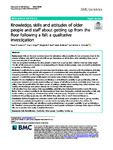Knowledge, skills and attitudes of older people and staff about getting up from the floor following a fall: a qualitative investigation
| dc.contributor.author | Swancutt, Dawn | |
| dc.contributor.author | Hope, SV | |
| dc.contributor.author | Kent, BP | |
| dc.contributor.author | Robinson, M | |
| dc.contributor.author | Goodwin, VA | |
| dc.date.accessioned | 2020-10-12T17:25:12Z | |
| dc.date.available | 2020-10-12T17:25:12Z | |
| dc.date.issued | 2020-10-06 | |
| dc.identifier.issn | 1471-2318 | |
| dc.identifier.issn | 1471-2318 | |
| dc.identifier.other | 385 | |
| dc.identifier.uri | http://hdl.handle.net/10026.1/16525 | |
| dc.description.abstract |
<jats:title>Abstract</jats:title> <jats:sec> <jats:title>Background</jats:title> <jats:p>Falls are the most common reason for ambulance callouts resulting in non-conveyance. Even in the absence of injury, only half of those who fall can get themselves up off the floor, often remaining there over an hour, increasing risk of complications.</jats:p> <jats:p>There are recognized techniques for older people to learn how to get up after a fall, but these are rarely taught. The aim of this study was to develop an understanding of attitudes of older people, carers and health professionals on getting up following a fall.</jats:p> </jats:sec> <jats:sec> <jats:title>Methods</jats:title> <jats:p>A qualitative focus group and semi-structured interviews were conducted with 28 participants, including community-dwelling older people with experience of a non-injurious fall, carers, physiotherapists, occupational therapists, paramedics and first responders. Data were transcribed and analysed systematically using the Framework approach. A stakeholder group of falls experts and service users advised during analysis.</jats:p> </jats:sec> <jats:sec> <jats:title>Results</jats:title> <jats:p>The data highlighted three areas contributing to an individual’s capability to get-up following a fall: the environment (physical and social); physical ability; and degree of self-efficacy (attitude and beliefs about their own ability). These factors fell within the wider context of making a decision about needing help, which included what training and knowledge each person already had to manage their fall response.</jats:p> <jats:p>Staff described how they balance their responsibilities, prioritising the individual’s immediate needs; this leaves limited time to address capability in the aforementioned three areas. Paramedics, routinely responding to falls, only receive training on getting-up techniques from within their peer-group. Therapists are aware of the skillset to breakdown the getting-up process, but, with limited time, select who to teach these techniques to.</jats:p> </jats:sec> <jats:sec> <jats:title>Conclusion</jats:title> <jats:p>Neither therapists nor ambulance service staff routinely teach strategies on how to get up, meaning that healthcare professionals largely have a reactive role in managing falls. Interventions that address the environment, physical ability and self-efficacy could positively impact on peoples’ capability to get up following a fall. Therefore, a more proactive approach would be to teach people techniques to manage these aspects of future falls and to provide them easily accessible information.</jats:p> </jats:sec> | |
| dc.format.extent | 385- | |
| dc.format.medium | Electronic | |
| dc.language | en | |
| dc.language.iso | en | |
| dc.publisher | Springer Science and Business Media LLC | |
| dc.subject | Capability | |
| dc.subject | Falls | |
| dc.subject | Getting up | |
| dc.subject | Older people | |
| dc.subject | Qualitative | |
| dc.subject | Rehabilitation | |
| dc.subject | Accidental Falls | |
| dc.subject | Aged | |
| dc.subject | Aged, 80 and over | |
| dc.subject | Ambulances | |
| dc.subject | Attitude | |
| dc.subject | Focus Groups | |
| dc.subject | Humans | |
| dc.subject | Independent Living | |
| dc.title | Knowledge, skills and attitudes of older people and staff about getting up from the floor following a fall: a qualitative investigation | |
| dc.type | journal-article | |
| dc.type | Journal Article | |
| dc.type | Research Support, Non-U.S. Gov't | |
| plymouth.author-url | https://www.ncbi.nlm.nih.gov/pubmed/33023509 | |
| plymouth.issue | 1 | |
| plymouth.volume | 20 | |
| plymouth.publication-status | Published | |
| plymouth.journal | BMC Geriatrics | |
| dc.identifier.doi | 10.1186/s12877-020-01790-7 | |
| plymouth.organisational-group | /Plymouth | |
| plymouth.organisational-group | /Plymouth/Faculty of Health | |
| plymouth.organisational-group | /Plymouth/Faculty of Health/Peninsula Medical School | |
| plymouth.organisational-group | /Plymouth/REF 2021 Researchers by UoA | |
| plymouth.organisational-group | /Plymouth/REF 2021 Researchers by UoA/UoA03 Allied Health Professions, Dentistry, Nursing and Pharmacy | |
| plymouth.organisational-group | /Plymouth/Research Groups | |
| plymouth.organisational-group | /Plymouth/Research Groups/FoH - Community and Primary Care | |
| plymouth.organisational-group | /Plymouth/Research Groups/Institute of Health and Community | |
| plymouth.organisational-group | /Plymouth/Research Groups/Institute of Translational and Stratified Medicine (ITSMED) | |
| plymouth.organisational-group | /Plymouth/Research Groups/Institute of Translational and Stratified Medicine (ITSMED)/CCT&PS | |
| plymouth.organisational-group | /Plymouth/Research Groups/Plymouth Institute of Health and Care Research (PIHR) | |
| plymouth.organisational-group | /Plymouth/Users by role | |
| plymouth.organisational-group | /Plymouth/Users by role/Academics | |
| dc.publisher.place | England | |
| dcterms.dateAccepted | 2020-09-24 | |
| dc.rights.embargodate | 2020-10-14 | |
| dc.identifier.eissn | 1471-2318 | |
| dc.rights.embargoperiod | Not known | |
| rioxxterms.versionofrecord | 10.1186/s12877-020-01790-7 | |
| rioxxterms.licenseref.uri | http://www.rioxx.net/licenses/all-rights-reserved | |
| rioxxterms.licenseref.startdate | 2020-10-06 | |
| rioxxterms.type | Journal Article/Review |


